




|

|

|
HOW TO CHANGE THE ENGINE OIL IN YOUR HARLEY DAVIDSON TWINCAM SOFTAIL. Regular oil and filter changes in your Harley is probably the single biggest thing affecting how long the engine will live. If you're reading this then you want to change the engine oil and filter yourself and its a really easy job you can do at home with a few basic tools. The service manual recommends changing the engine oil every 5000 miles (8000 kms) but I halve the intervals on my personal bikes. Every 2500 miles on the dot. I've found halving the service schedule for fluid and filter changes will let your bike live long and strong. There's an old saying that goes "Oil and filters are cheap, motors are not". You'll need some engine oil. The manual recommends no more than 3.3 Litres (3.5 Quarts) to fill the oil tank. I've found that around 2.5 Litres (2.65 Quarts) will fill the tank to the proper level on my '05 Softail. There is a myriad on engine oils out there on the market and choosing an oil for your Harley is a bit of a minefield. There is a lot of differing opinion on engine oils out there too but a combination of wrenching on my own stuff for 25 years and some heavy duty research on the subject has given me some firm ideas on the subject. Engine break in: motors with less than 1000 miles on them need breaking in to allow all the wearing surfaces to gently lap together in a controlled environment. I use a good mineral oil for this and dump it right on 1000 miles. I believe that modern semi synthetic and straight synthetic oils are so slippery that they don't allow the lapping process to complete in that first break in period. Remember what we are talking about here, an aircooled slow revving V-twin that has its design roots in the 1930's. Normal oil change: I use the best synthetic oil I can lay my hands on and dump it every 4000kms (2500 miles) religiously. After many, many hours scouring the net for info I believe the best synthetic oil for your Harley is either Amsoil or Mobil 1. The only laboratory measured difference between Mobil 1 V-Twin blend and the cheaper Mobil 1 car oil is that the car oil has a slightly higher molybdenum content than the bike oil and the bike oil has a higher price tag. There are no wet clutches inside a Harley motor, so if anything the higher molybdenum content in the Mobil 1 car oil is going to be the better (and cheaper) choice of the two. The Mobil 1 comes out fairly clean @ 4000 kms (2500 miles) and I never have any metallic fuzz on the engine oil drain plug magnet. Independent testing results also confirm that both Amsoil and Mobil 1 were the only two motorcycle oils to retain 70% or more of their initial viscosity rating after 1500 miles in a working engine. Viscosity breakdown = engine wear, no two ways about it. Granted, synthetic oil costs more but if you change your own oil and filter it'll cost you less than $50 per oil change for the best protection on the market. Bargain !! You're gonna need a few basic tools, oil and a filter; I've listed them below: An imperial socket set that includes a 5/8 socket, a ratchet and a short / long extension bars. 3/8 drive socket sets are really cheap down at the local car accessories emporium and try to find one with a uni-joint extension included, it'll make it far easier when you want to change your Hog's gearbox oil as well. An engine oil filter removal tool. There are several different kinds on the market and the one in the pictures below is the same as the genuine HD one the stealership will sell you except that this one only cost me seven dollars at the local car parts joint. Its made in Taiwan and works perfectly. A funnel... 2 bucks at the supermarket. A can of brake cleaner. 5 bucks at the car parts joint. Engine oil. Your choice here... stealerships will put either HD's standard mineral oil or HD's syn3 in your engine. Amsoil and Mobil 1 outperform both of those oils without even raising a sweat. Engine oil filter. There are several good ones on the market but I stick with either the K&N or the genuine HD 5 micron one. An engine oil drain plug O-ring... a couple of bucks from the stealership. A small torque wrench is also very handy but don't worry if you haven't got one, its not mandatory for this How -To. The torque values we're dealing with are small and easily achievable by hand. Once you've got your tools assembled, find a few clean rags and an oil drain pan. Find somewhere level, clean and clutter free to work on your bike. Today I put my bike on the back patio to get better lighting for photo's but I usually work on her in the garage. Righto, time to get dirty. First, run your motor for a few minutes to put some heat in the oil and make it easier to change (it will flow more easily) Next locate your engine oil drain plug. Its a little tricky to see at first and is recessed up into the underside of the frame on the same side as your pipes. 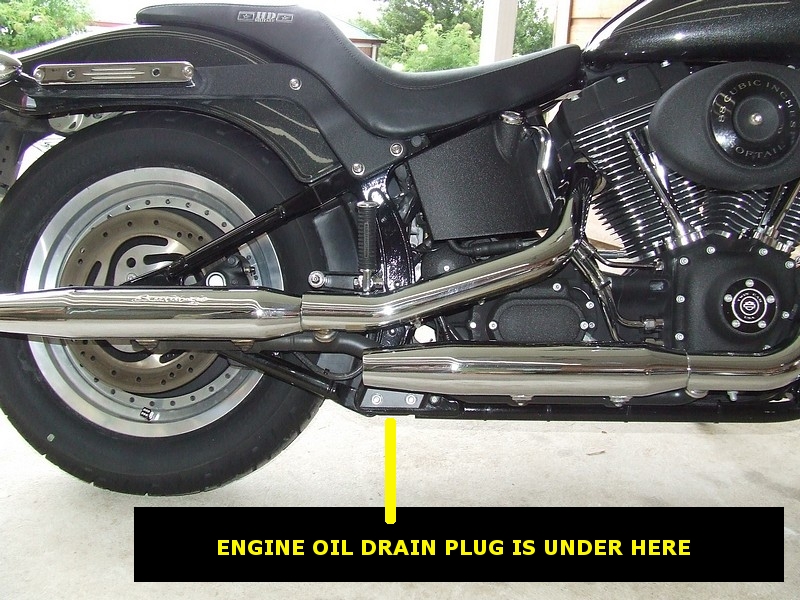
The best bet is to plonk your ass on the deck and stick your head under the bike for a look.
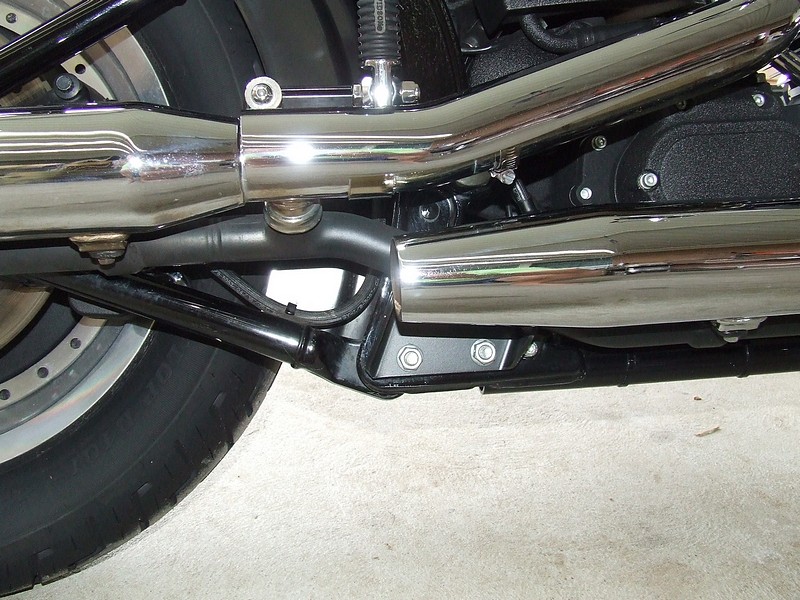
When you do this is what you'll see.
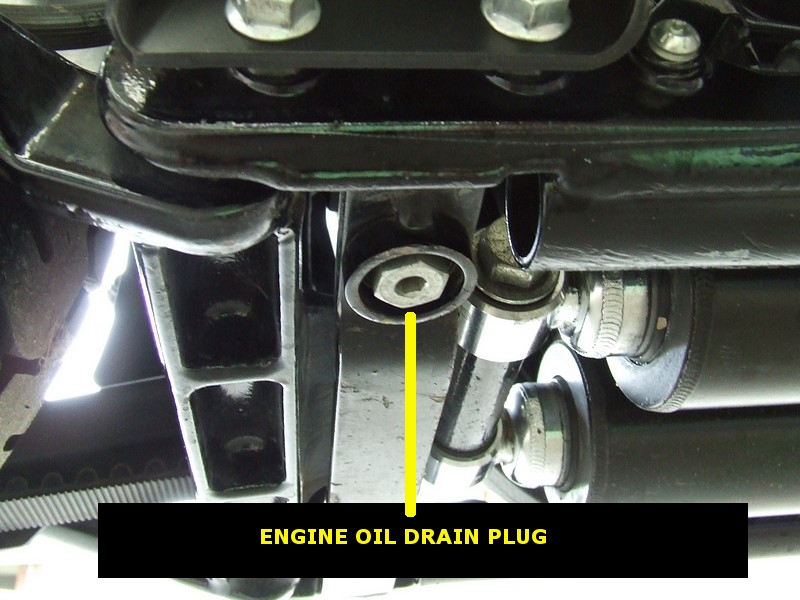
Locate your engine oil filler plug (which doubles as the dipstick) near the seat.
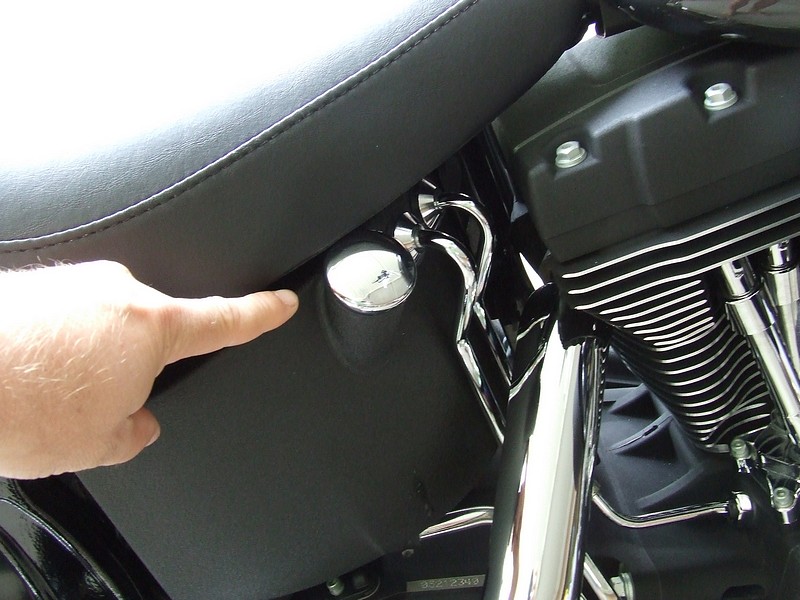
Pull that sucker out and wipe it clean with a shop rag. Stash it somewhere safe. 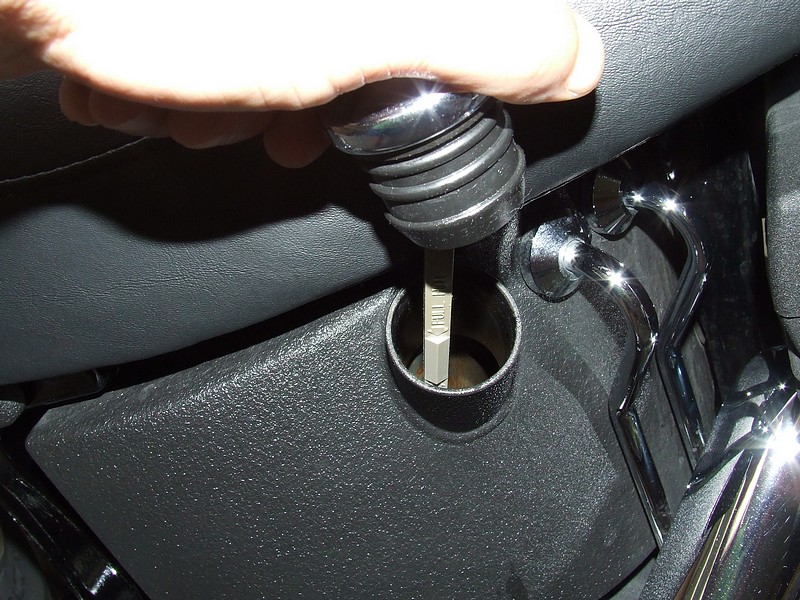
By removing the filler plug first, your engine oil will empty out faster when we pull the drain plug. 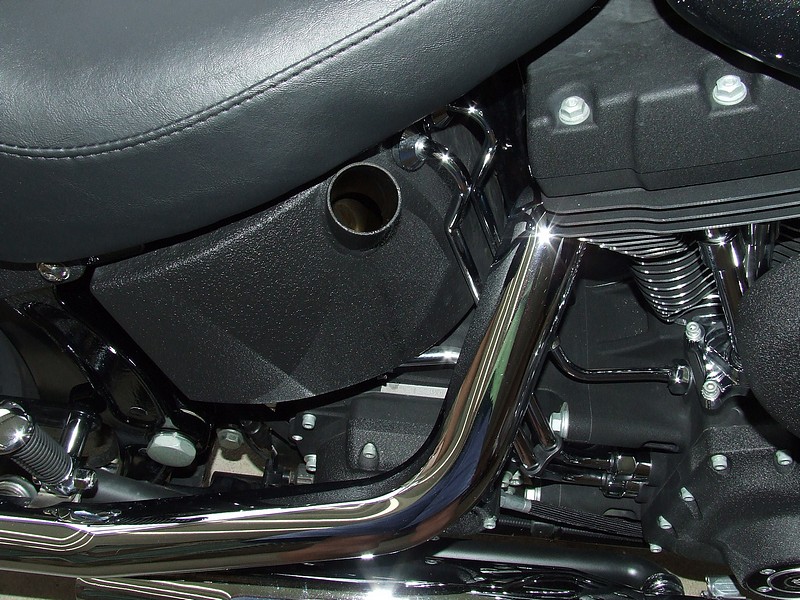
Grab your socket set and find the 5/8 socket and a ratchet. 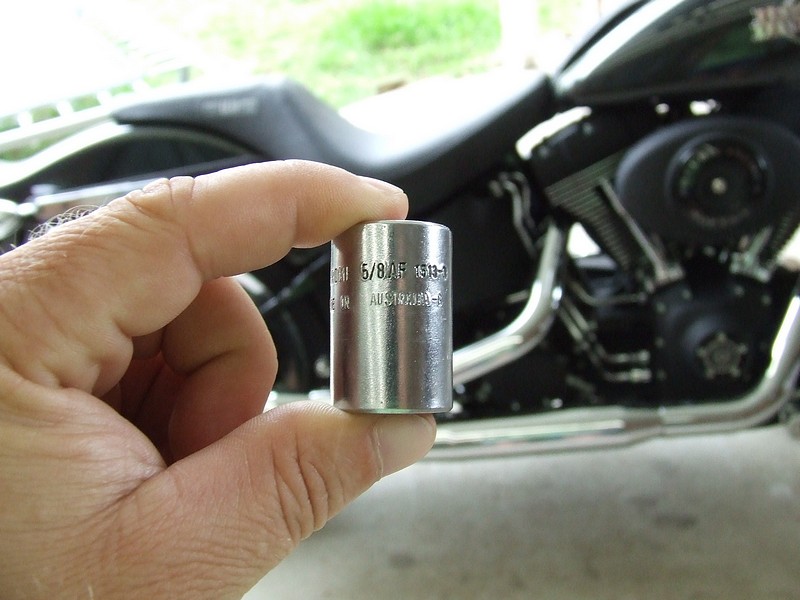
It was a bit windy on the day I did this outside so I've used an old drop sheet to stop oil spray from landing on the concrete. If you're working in your garage then just go for the oil tray. 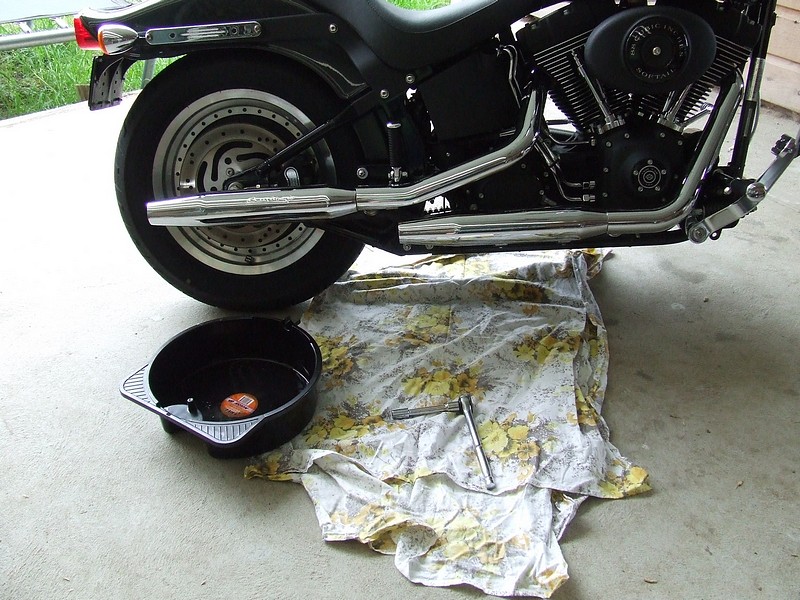
Locate your socket over the drain plug and make sure its pushed all the way up. 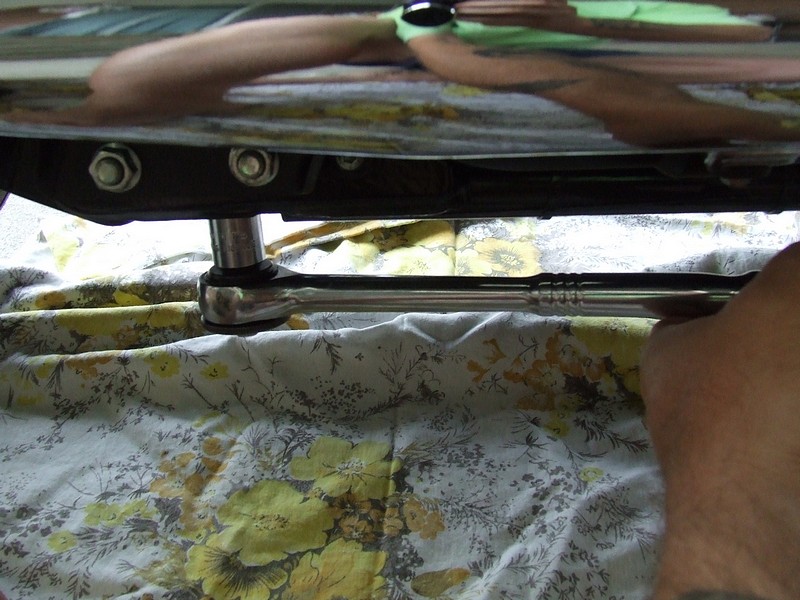
Go ahead and crack the plug loose. 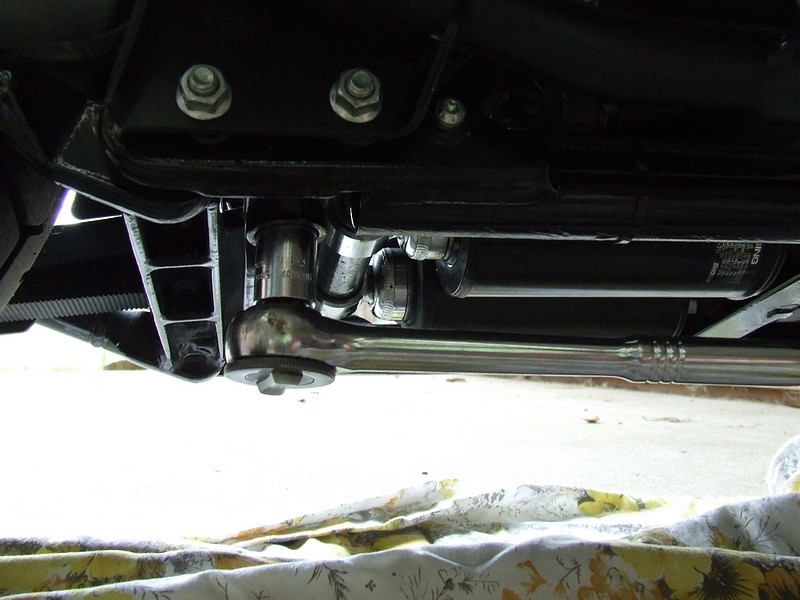
Once the plug is past its initial tight stage, slip the drain pan under it and use the socket to undo the plug enough to grasp it by hand (note the disposable rubber glove). 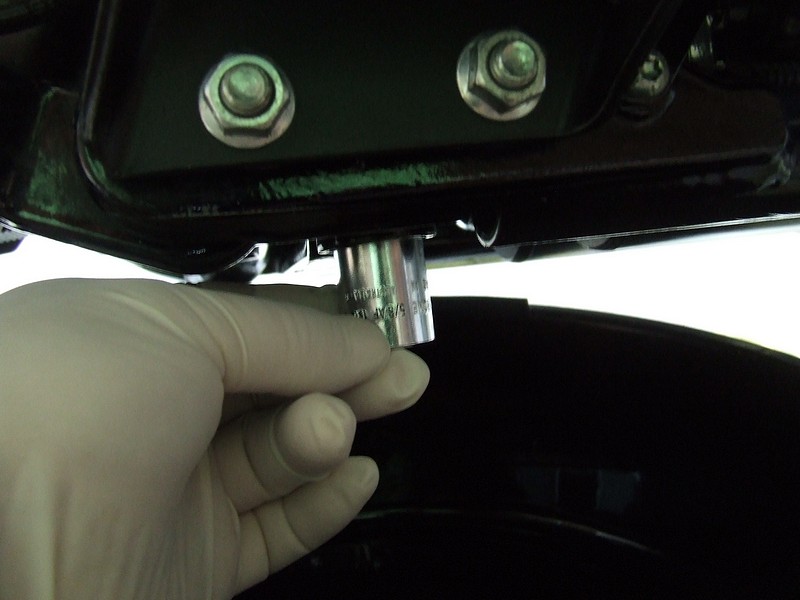
Double check your drain pan is in the right place. 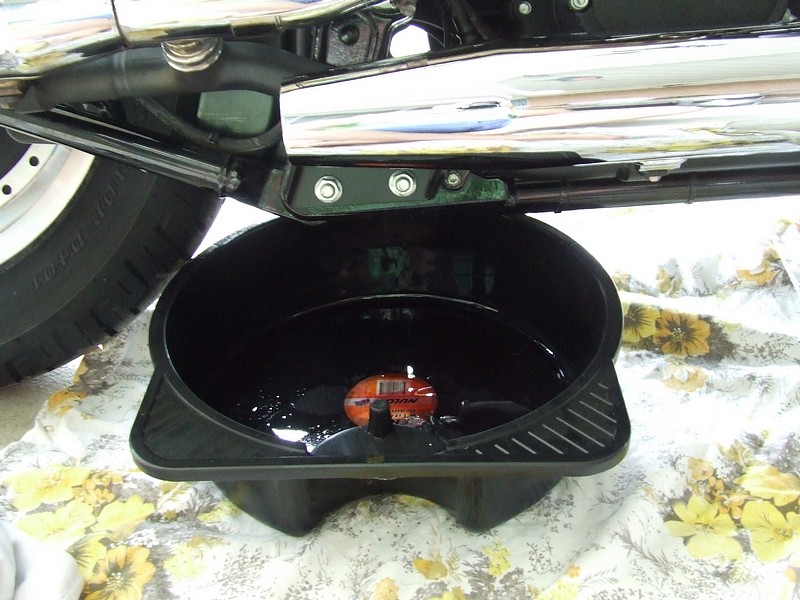
You can see the plug is far enough out to undo it by hand. 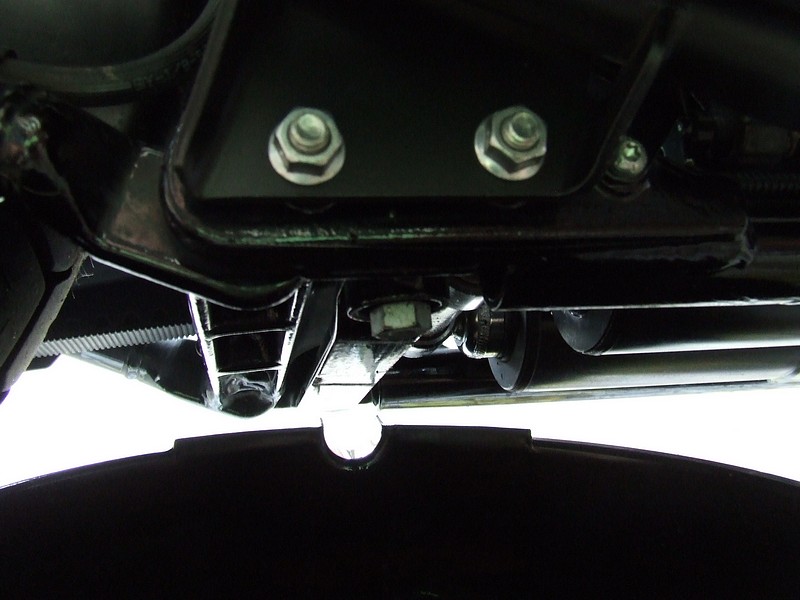
Go ahead and remove the drain plug. 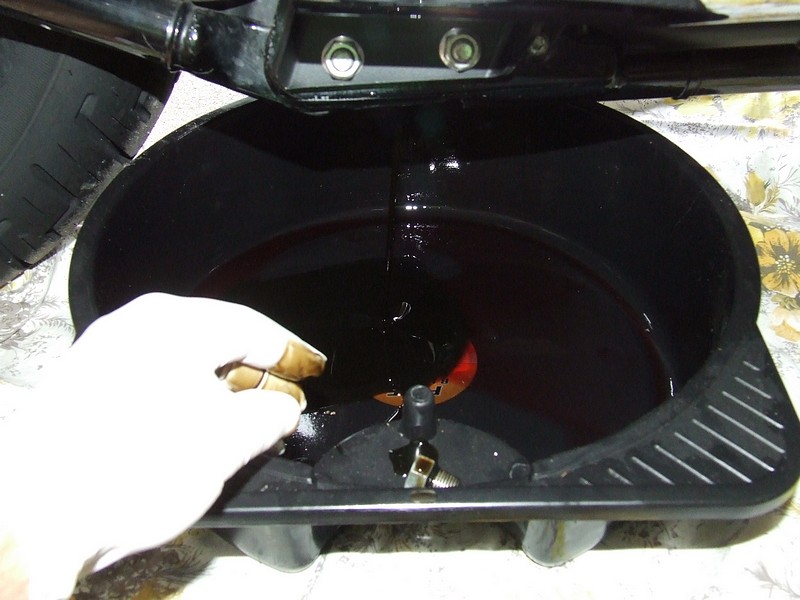
Ball your fist and pull the glove off, turning it inside out and trapping the oil. Dump it in the bin. 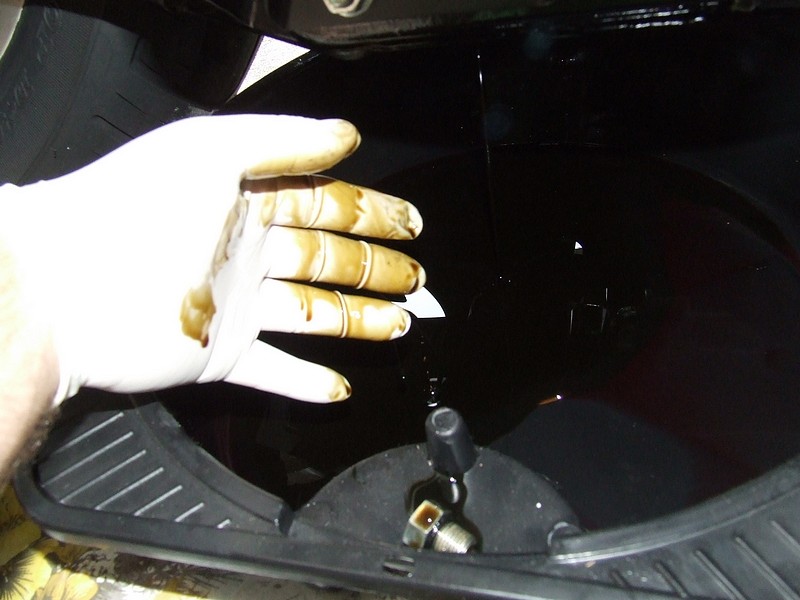
Gimme the good oil !! 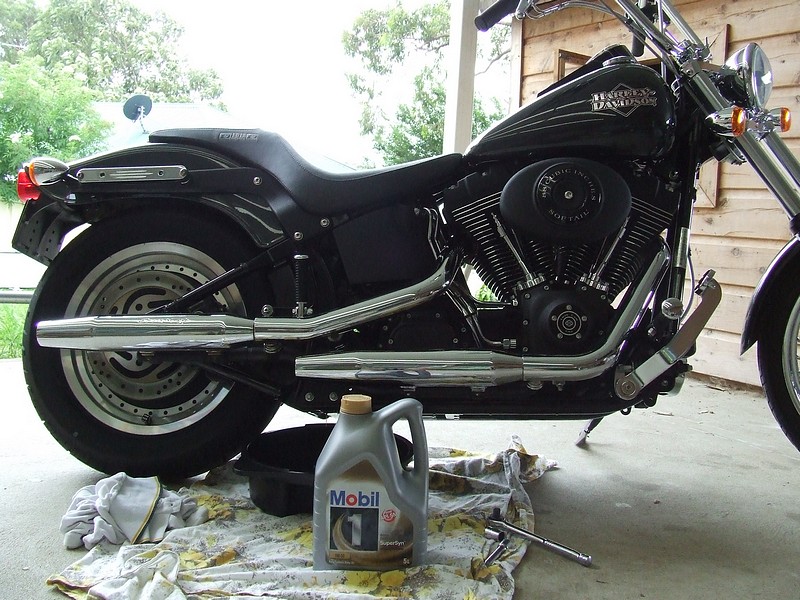
The engine oil plug as it came out. Note a complete lack of metal fuzz on the embedded magnet even after 2500 miles... Mobil 1 .... love the stuff ! 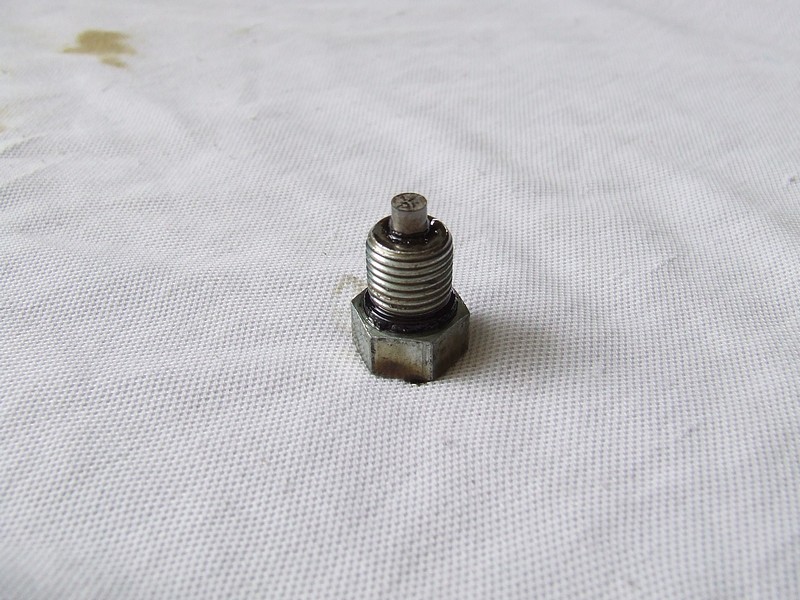
Plug as removed, side on shot... no fuzz !! 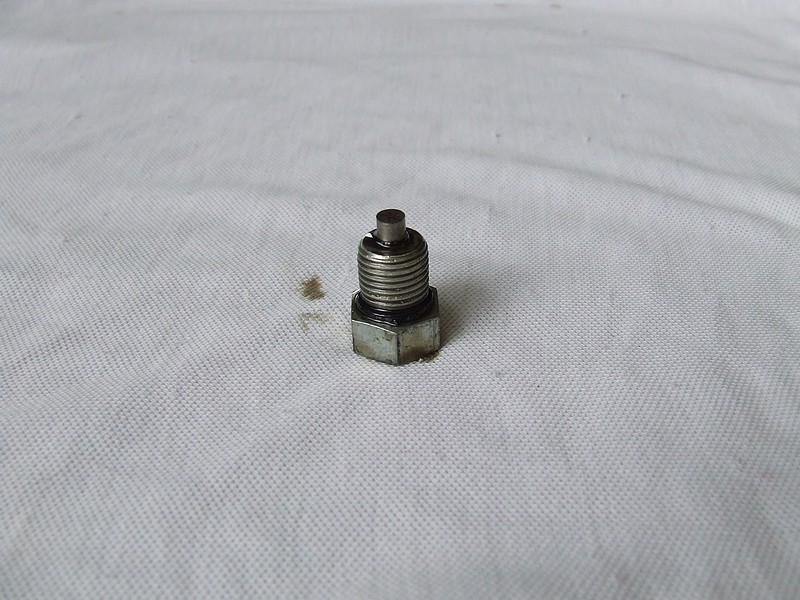
But the O-ring is perished. Time for a new one ! 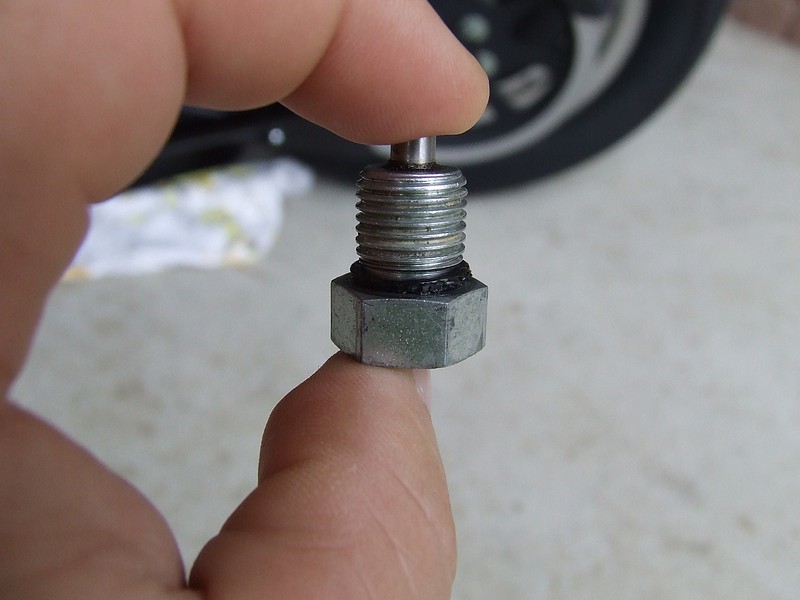
Next replace the drain plug and torque to 20 foot pounds. No torque wrench ? Then tighten by hand with the ratchet to "gently firm" ... use about 30% hand strength on the ratchet. Now you can locate your engine oil filter. 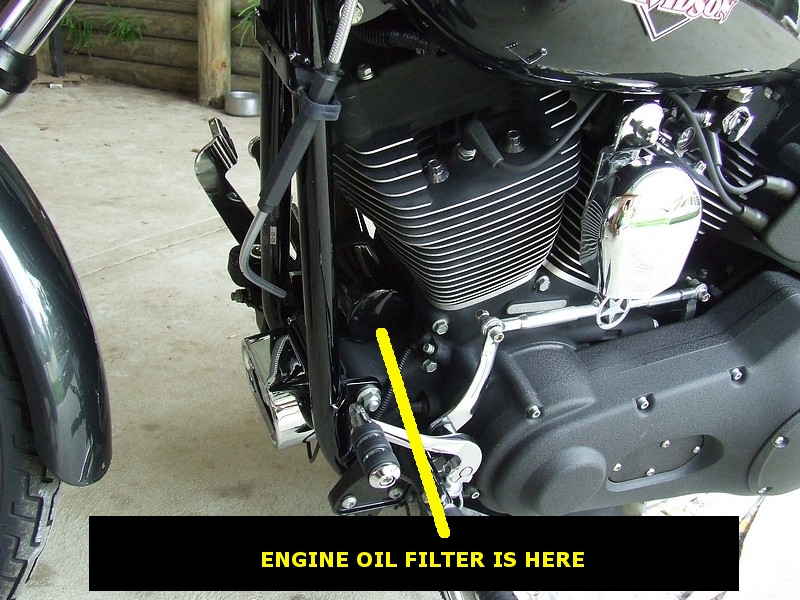
Close up of the oil filter. 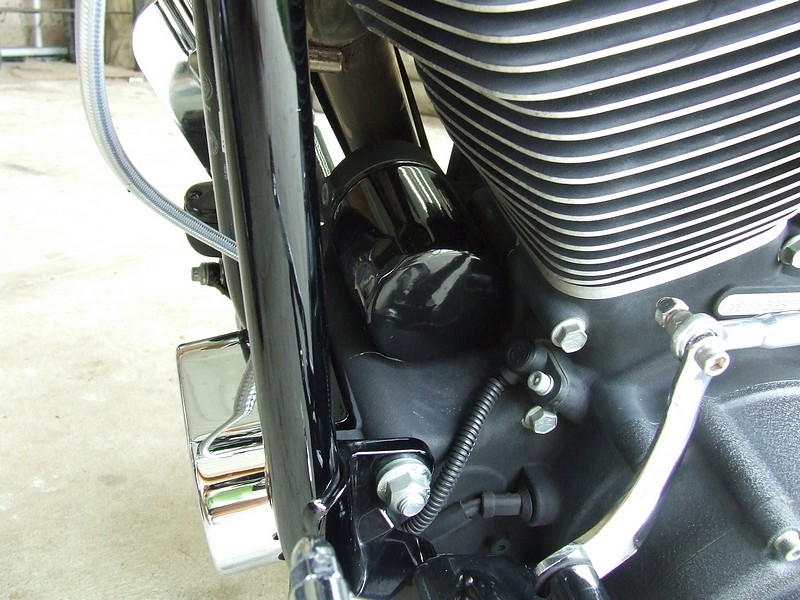
Close up from front on. Note the limited room you have to work with to get the filter off. Make sure you get a filter removal tool that will fit ! 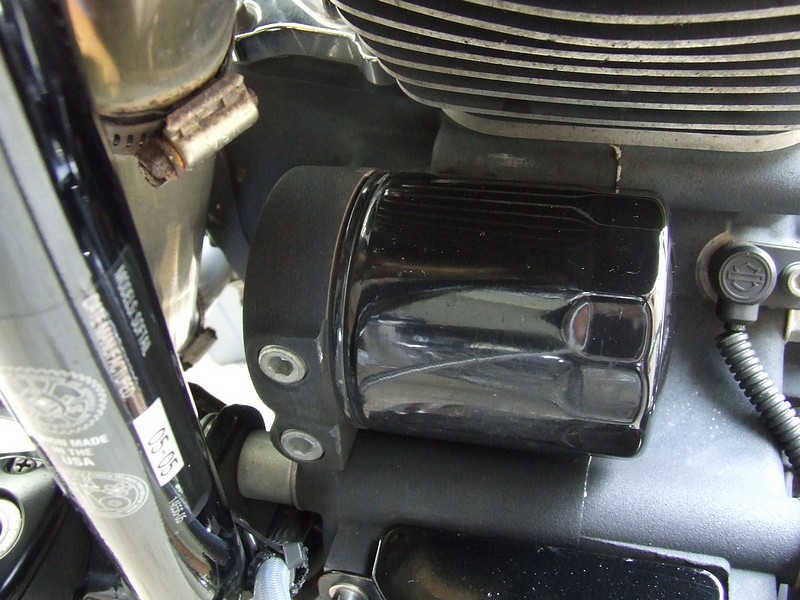
Now I bet you're wondering what the hell a coke bottle is doing in this how-to.... 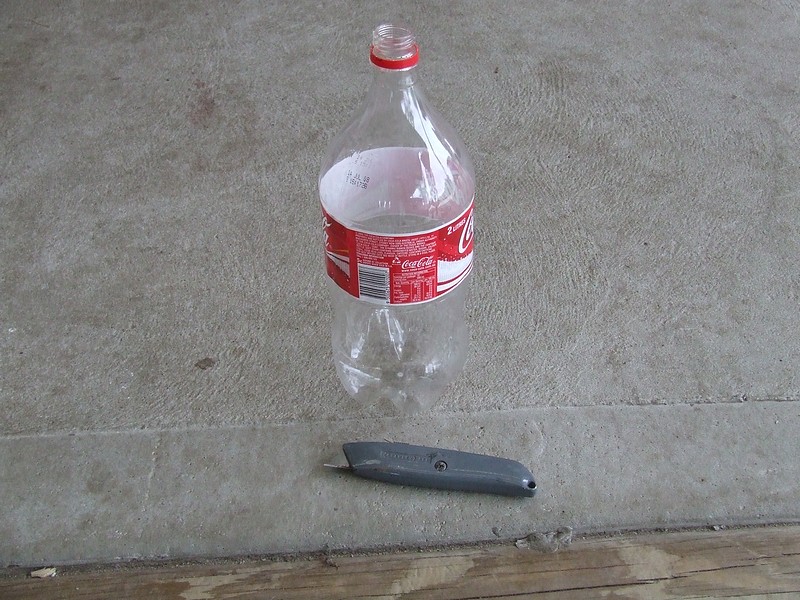
Well, we're going to make a "filter catcher". After you unscrew the filter its going to be covered in engine oil and very slippery, not to mention messy. Start by cutting the arse out of the bottle. 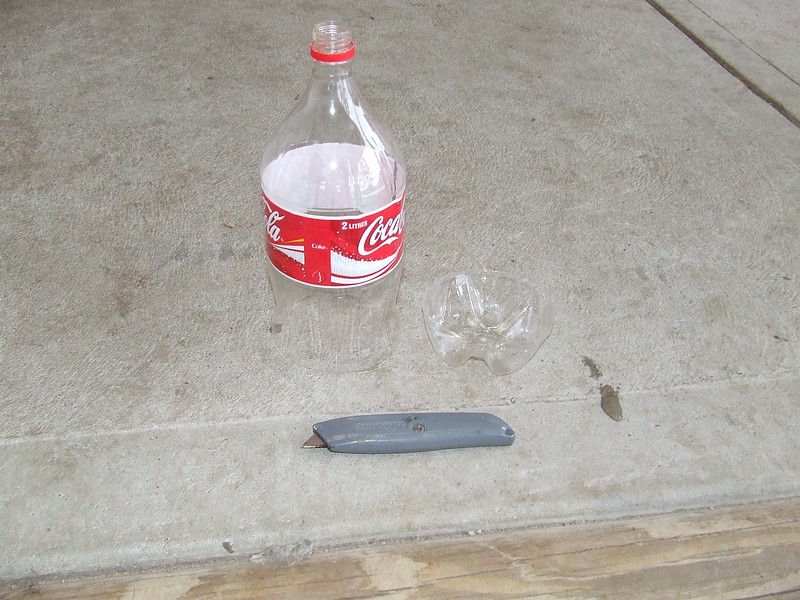
Cut the bottle to this shape. Its easier if you make two cuts, starting up near the neck of the bottle both times. 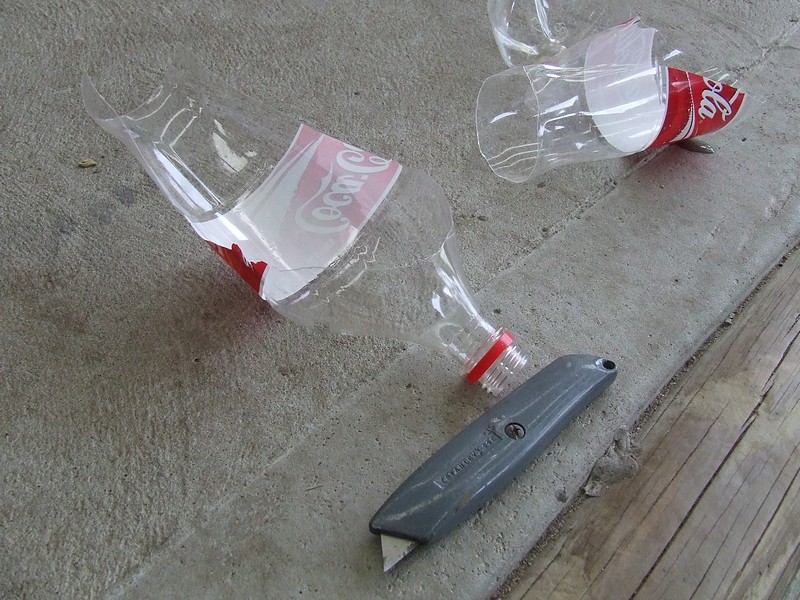
Test it out for fitment underneath the filter. 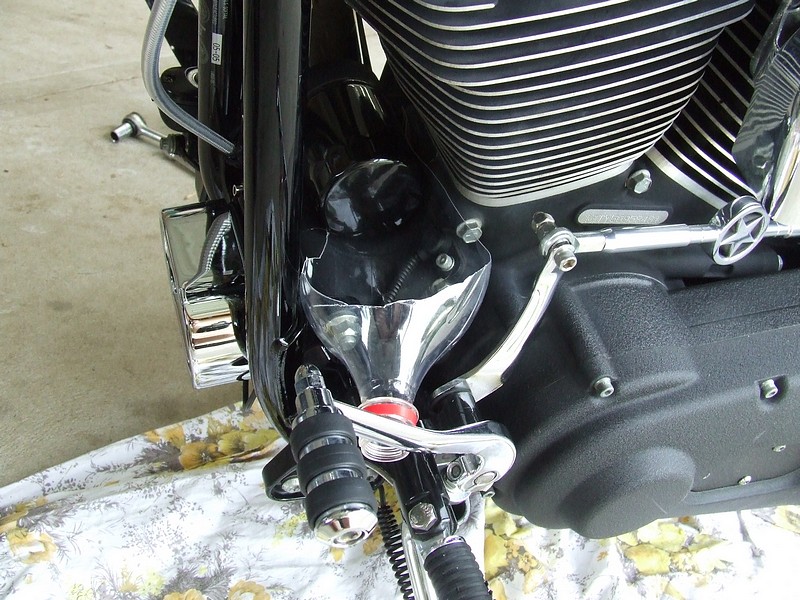
Here is the filter wrench I bought for 7 dollars. Its a cool cam action wrench that tightens up on the filter as you undo it to prevent slippage. The sizing is 2-3/4" to 3" (70 - 76 mm). 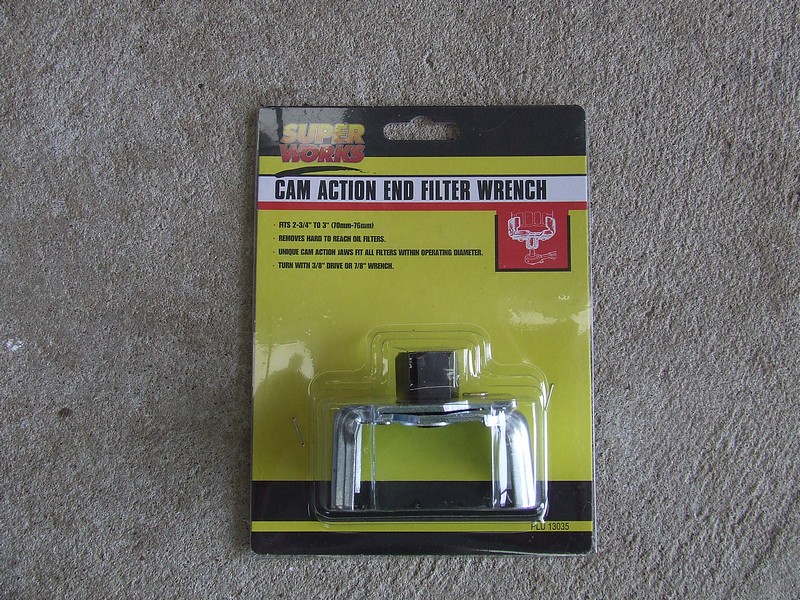
Start by slipping the filter wrench over the end of your oil filter, taking care not to hit the electrical plug located on the engine casing right next to the filter end. Another really cool thing about this filter wrench is that a 3/8 drive extension bar clicks straight into the end of it ! 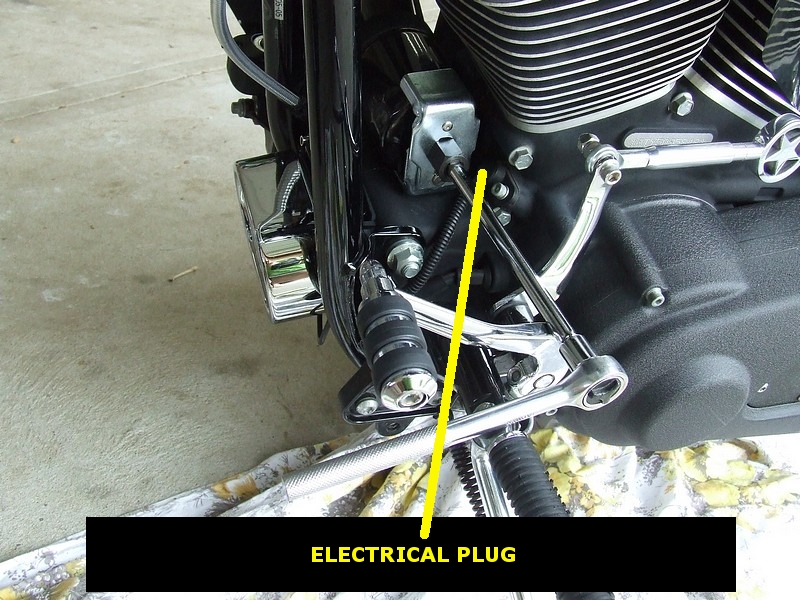
Throw your drain pan under the front of your bike, right under your left footpeg. Crack the filter loose. Be very careful with the electrical plug located nearby. You'll need to take two or three small bites at it, resetting the filter wrench back to center each time. This will prevent damage to your case, barrels or the electrical plug from the steel of the filter wrench. Once you have cracked the seal on the filter, shove your custom coke bottle underneath it and whack on another rubber glove if you want. Spin off the filter and catch it in the bottle. 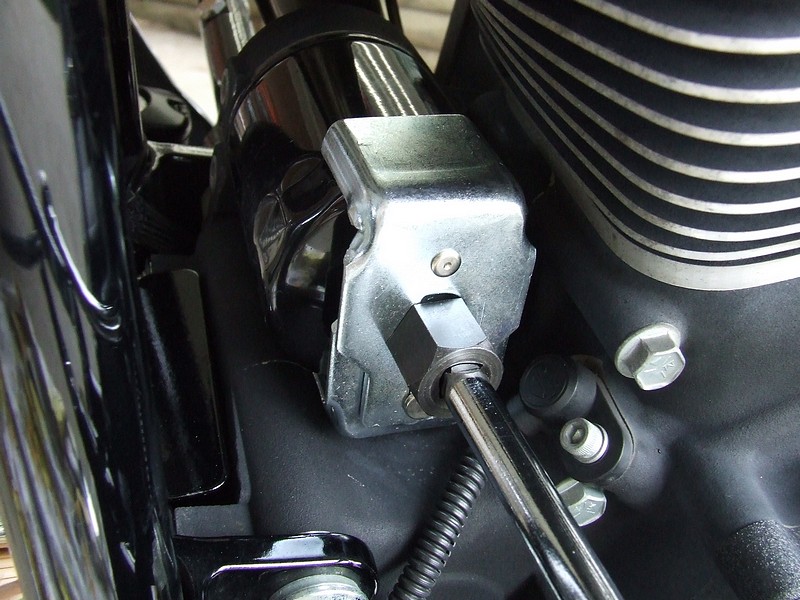
Here's the filter in the bottle, it slides straight in. Dispose of the old filter and coke bottle after you drain them of oil. 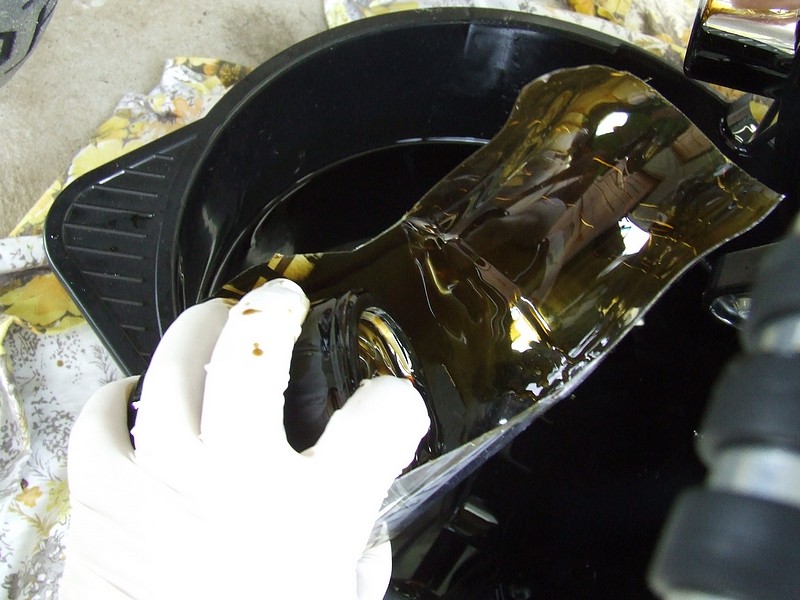
Draining the filter. 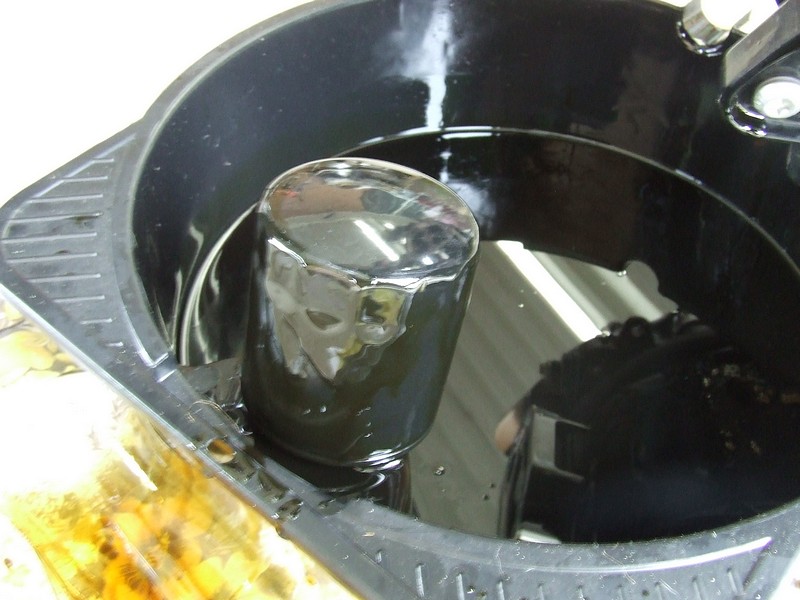
Brake cleaner. Damn good stuff, just keep it away from the paint on your tank and guards. 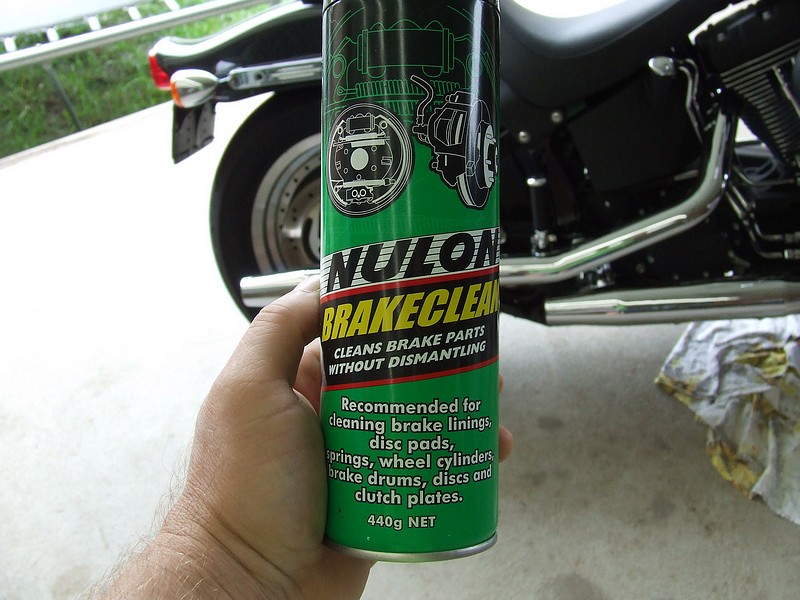
Throw an old shop rag onto your engine casing to soak up the worst of the oil spillage. 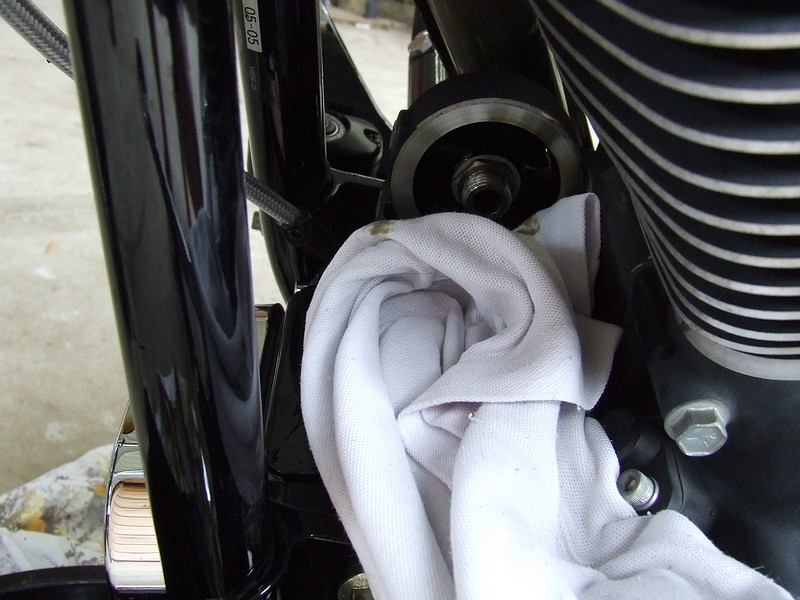
Give the area a good blast with the brake cleaner. This stuff evaporates off fast without leaving a residue so dont be scared to give it heaps. 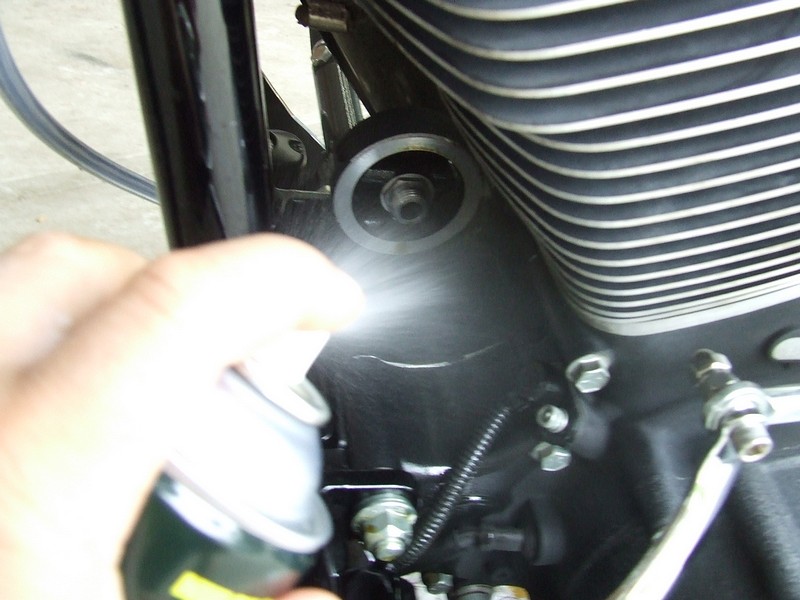
A genuine HD 5 micron filter... 15 bucks from the stealers. 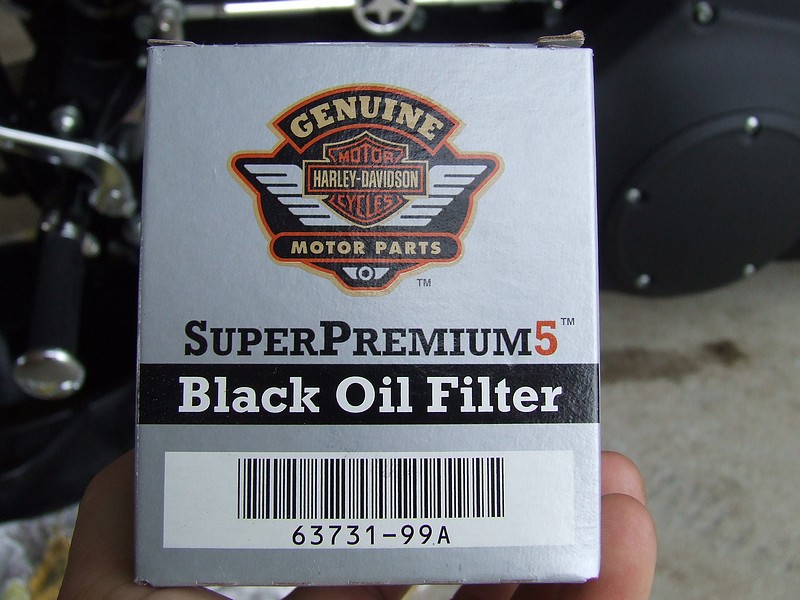
Find some flat ground and open up the box like this. 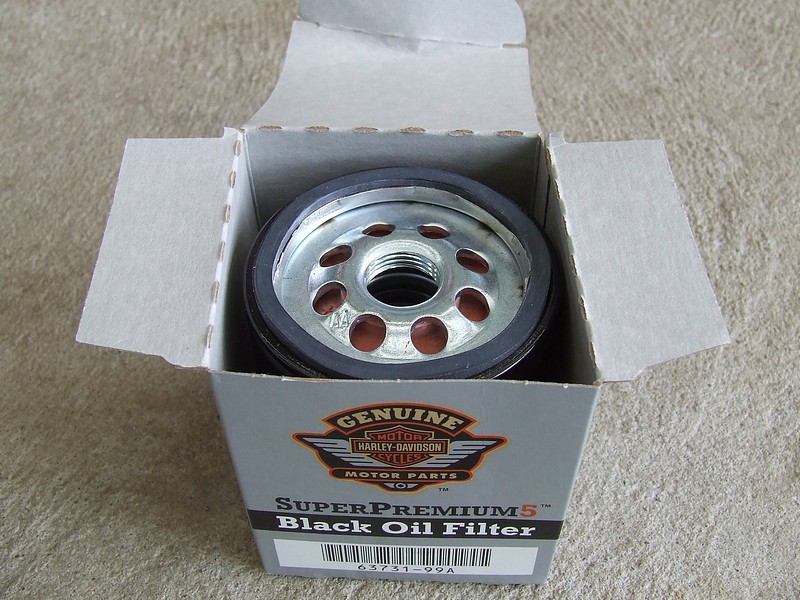
Here's a close up of the filter. Note the scorch marks still on it from spot welding the casing during construction ! 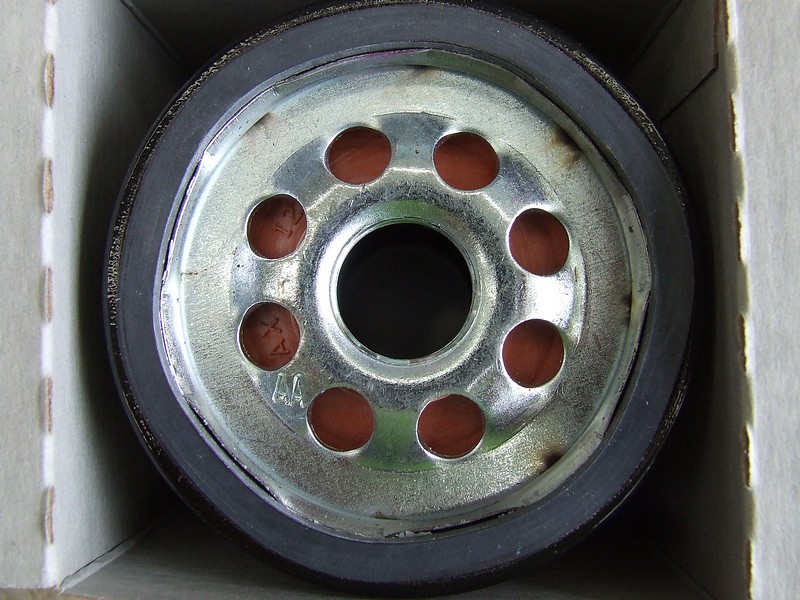
Grab your engine oil and start filling up the filter. Paper element filters like these ones need pre-wetting before being screwed onto your precious engine. 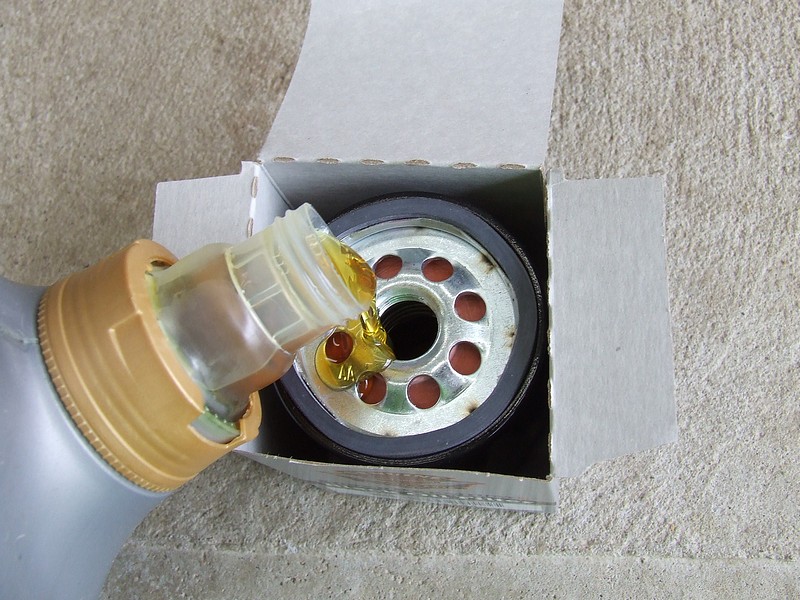
Fill the filter all the way up to the threads at the top. The paper will soak most of it up again in 20 seconds and it won't spill out when you turn the filter sideways to put it on your bike. If you dont pre-wet your filter then your motor will not get full oil pressure for those first 20 seconds after startup while the paper element soaks up oil. Not good. 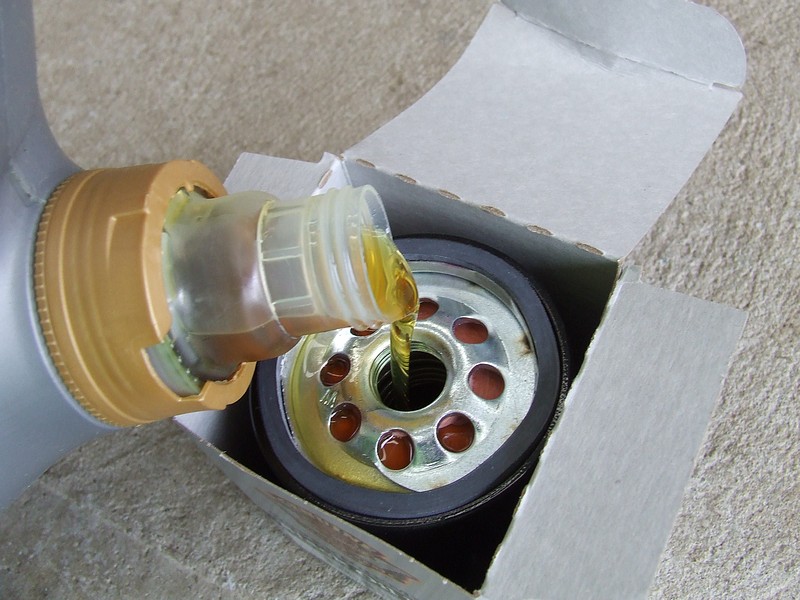
Get some clean oil on your finger. 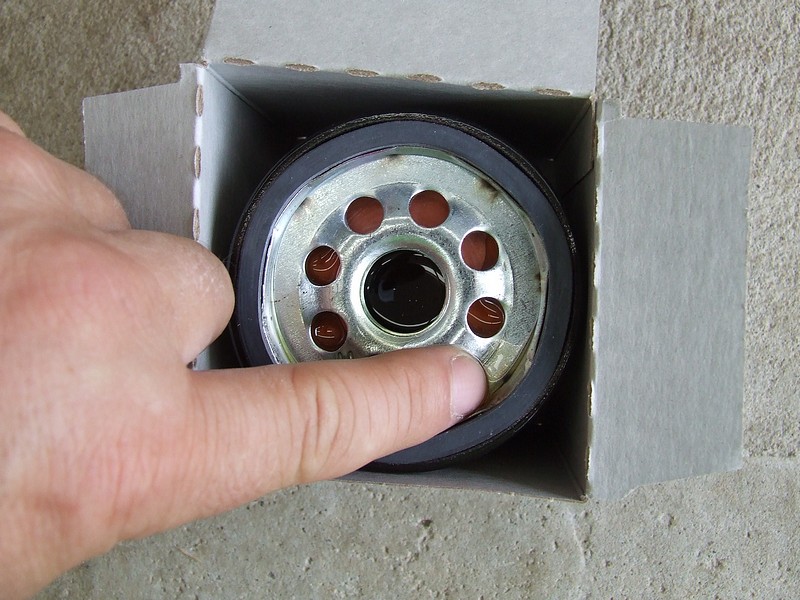
Smear a thin layer of oil on the rubber seal at the top. 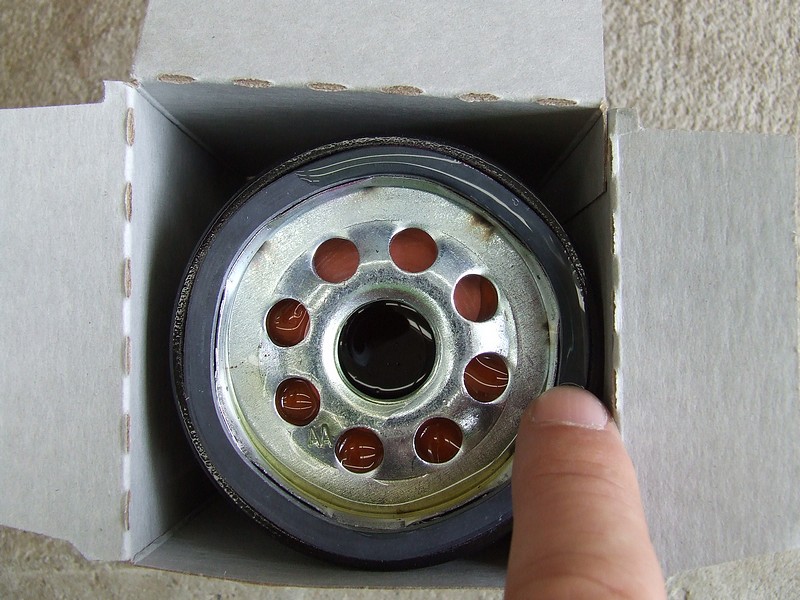
Make sure you get it all the way around. This will stop the rubber binding on the alloy motor casing and allow you to tighten it up properly, avoiding leaks. 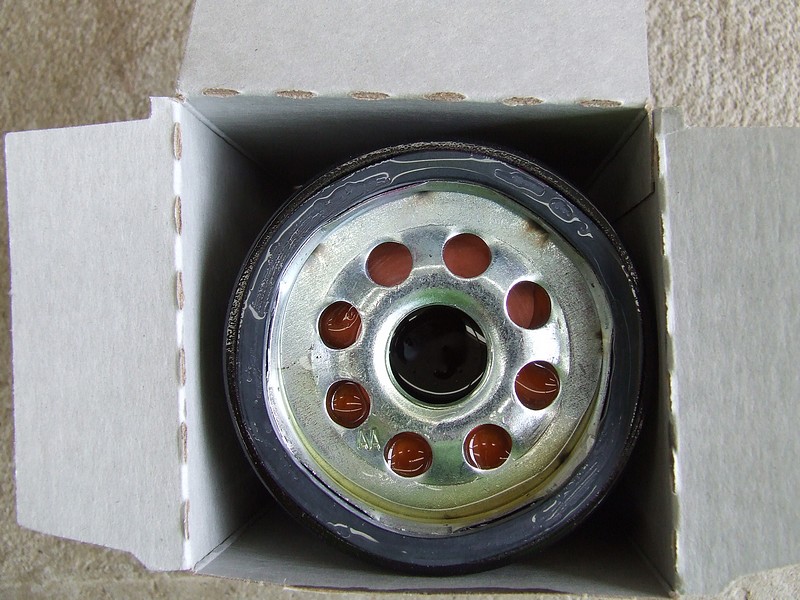
Spin the filter onto its housing. 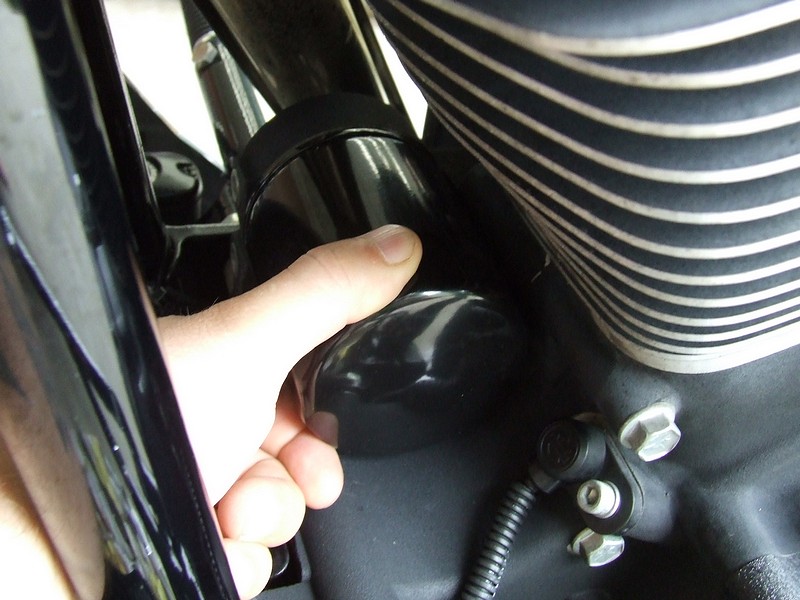
With oil on the seal you only need to tighten the filter hand tight. That is ... as tight as you can possibly get it just using your hands. The filter is designed to actually get tighter on its housing with time which is why you only do them up with your hands but you can't get them off again without a wrench ! Give the new filter a blast underneath with the brake clean again to remove any oil drips from installation. 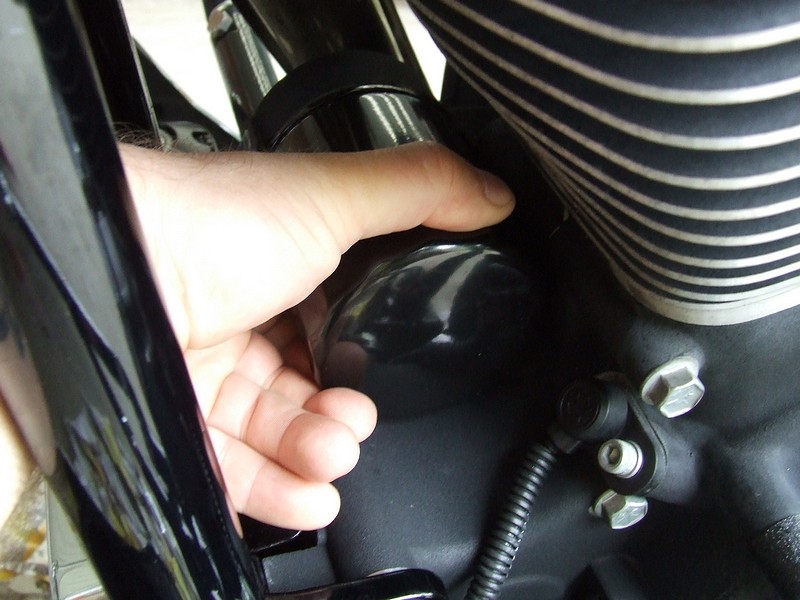
Fill up your oil tank with fresh engine oil. I find 2.5 litres (2.6 quarts) fills my '05 softail to the correct height on the dipstick, your bike may use a little more or a little less. Fill the oil tank to about 1" under the filler neck bottom and use your dipstick as a guide to slowly come up to the right level. 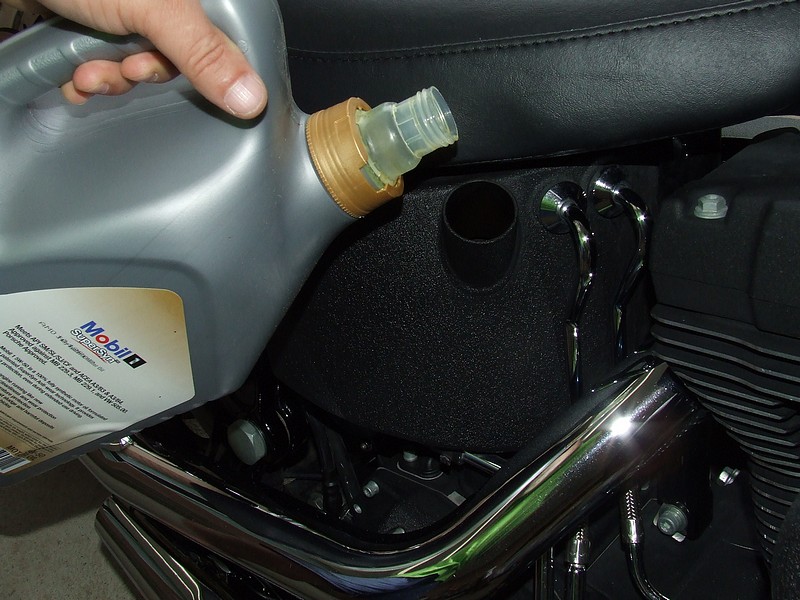
The dipstick out of the bike. It looks slightly overfull but the bike is cold. My engine oil level drops slightly after the bike is run a short time and all the air is purged from the oil galleries around the motor. 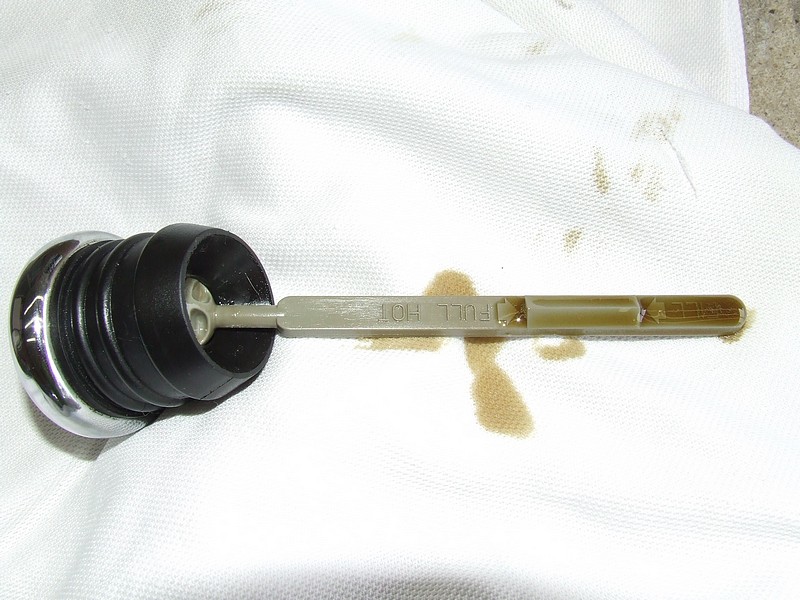
Conclusion?
Extremely easy to do in an afternoon, your bike will really love you for it.
|
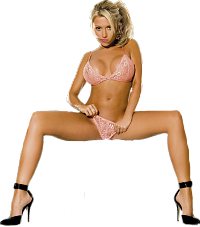
Enjoy this article ? The site ? Would you buy me a beer for my efforts?


|

|

|